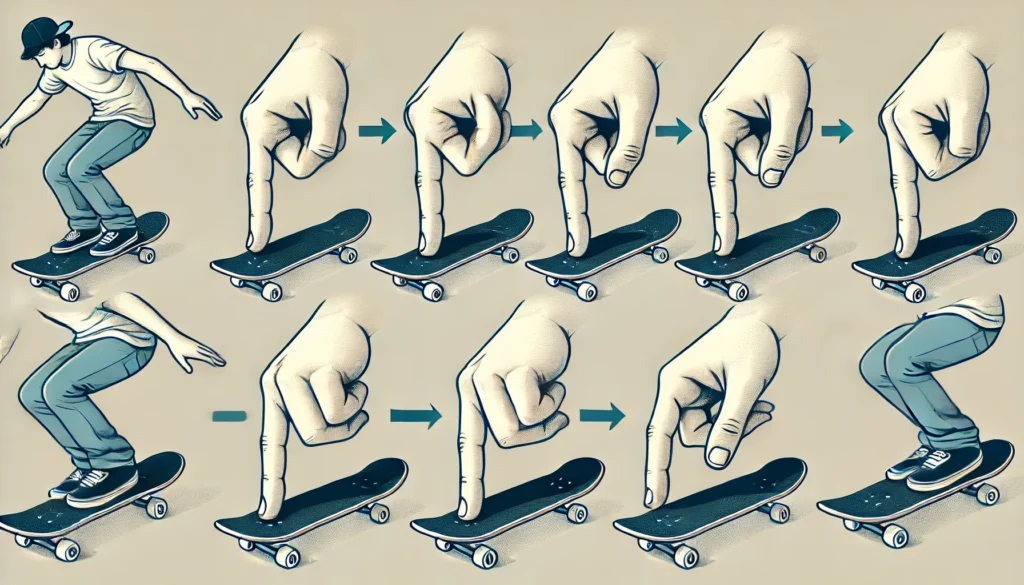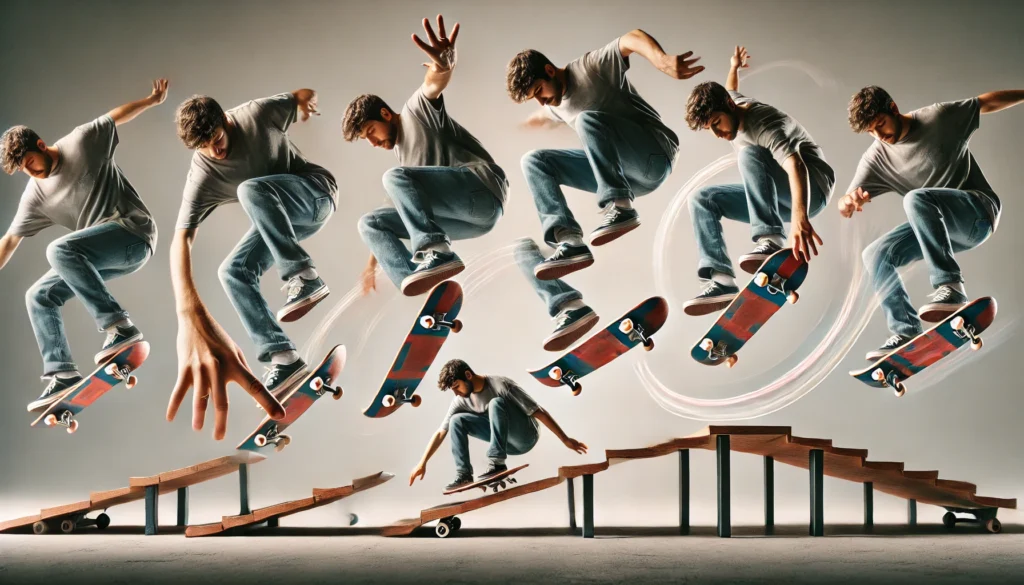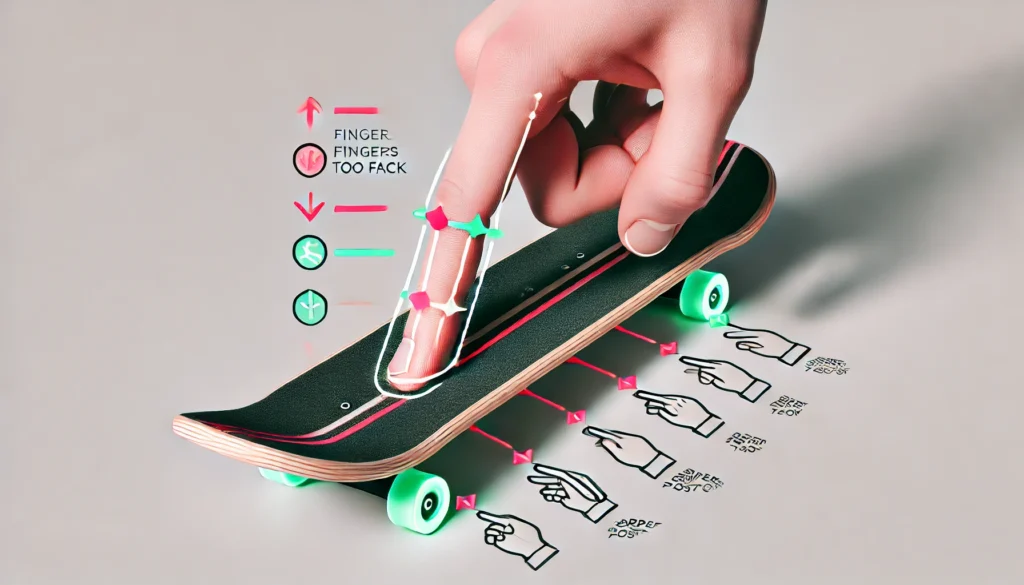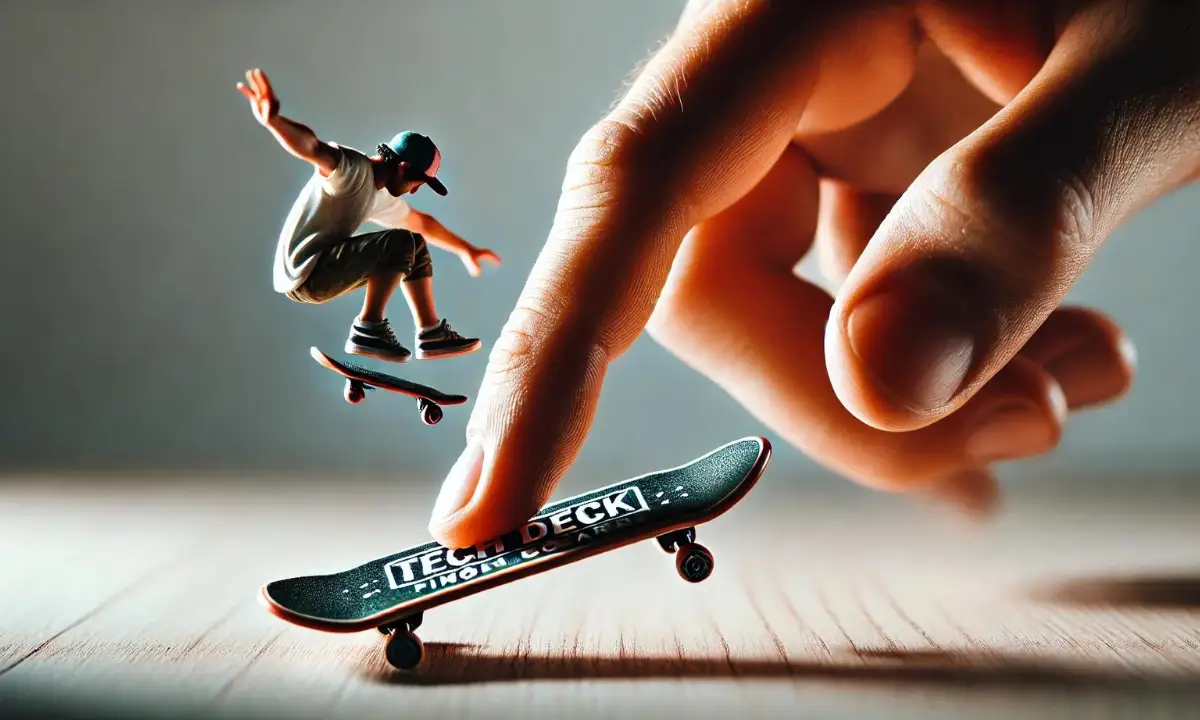Fingerboarding has become a growing trend over the past decade, particularly among skateboard enthusiasts looking for a fun, portable way to perform tricks. Tech Deck, the miniature skateboard brand, has become synonymous with fingerboarding, offering a platform for creativity, skill-building, and even competition. What started as a toy for kids has grown into a global phenomenon, with an estimated 1 million Tech Decks sold annually and an expansive online community dedicated to sharing tricks, tutorials, and creative setups.
In recent years, fingerboarding has evolved from a niche hobby to a cultural movement, attracting both seasoned skaters and beginners. It’s no longer just about playing with a mini skateboard—it’s about mastering real tricks and stunts, from ollies to kickflips, with just two fingers. According to industry reports, the fingerboarding market is projected to grow at a steady pace of 5.7% annually as more people discover the joy of fingerboarding. Tech Deck remains at the forefront of this movement, providing enthusiasts with high-quality boards that mimic the feel and performance of full-sized skateboards.
Whether you’re a seasoned skater looking to hone your finger coordination or a complete beginner eager to learn some cool tricks, this article is for you. We’ll take you through the essential Tech Deck tricks, offering step-by-step instructions that will help you progress from basic moves to more advanced techniques. So grab your Tech Deck, and let’s start fingerboarding!
What is a Tech Deck?
A Tech Deck is a small-scale, fully functional fingerboard that allows users to perform skateboard tricks with their fingers. Originally created in the late 1990s, Tech Decks quickly became a popular toy and hobby for skateboard enthusiasts of all ages. These tiny skateboards feature realistic graphics from well-known skateboarding brands and come with functioning wheels, trucks, and grip tape, giving the same feel as a real skateboard—only in miniature form.
Tech Decks are more than just toys; they’re tools for creativity and precision. Like traditional skateboarding, Tech Decking requires skill, practice, and control to perform tricks, making it an engaging hobby for people who love the challenge of mastering new techniques. The small size and portability of a Tech Deck make it easy to practice anywhere, whether you’re at home, in the office, or on the go.
Types of Tech Decks
There are various types of Tech Decks available to suit different skill levels and personal preferences:
- Plastic Tech Decks: These are the most common and affordable option. They’re great for beginners who are just starting out with fingerboarding.
- Wooden Tech Decks: These offer better grip and control, giving a more realistic feel similar to real skateboards. They’re usually favored by more experienced fingerboarders.
- Customizable Tech Decks: Advanced users can customize their Tech Decks by swapping out wheels, trucks, and grip tape to tailor their fingerboard to their preferences.
Why Tech Decking is Popular
The popularity of Tech Decks stems from their ability to replicate real skateboarding tricks on a much smaller scale. Whether you’re someone who skateboards in real life or just love the idea of mastering cool tricks with your fingers, Tech Decks offer hours of entertainment and challenge.
By improving hand-eye coordination, finger dexterity, and creativity, fingerboarding with a Tech Deck is a fun way to spend time, and it can even serve as a gateway to learning real skateboarding techniques.

Essential Fingerboarding Techniques for Beginners
Before diving into tricks, it’s crucial to understand the fundamentals of fingerboarding. Just like in real skateboarding, mastering the basics of balance, control, and finger positioning will set the foundation for all future tricks. Let’s go over the essential techniques every beginner should know to start fingerboarding like a pro.
Positioning Your Hands
The first step in fingerboarding is learning how to properly position your fingers on the Tech Deck. Typically, fingerboarders use two fingers: the index finger and the middle finger. The index finger should be placed near the middle of the board, acting as your control and balance point, while the middle finger is positioned toward the tail of the board, used for popping the deck to perform tricks.
- Step 1: Place your index finger at the center of the board, just above the trucks.
- Step 2: Position your middle finger on the tail of the board (the raised back end).
- Step 3: Keep your fingers lightly pressing on the deck—too much pressure will limit your control, while too little will make the board difficult to maneuver.
How to Gain Control & Balance
One of the most important skills to develop as a beginner is control. This refers to your ability to move the Tech Deck smoothly without it flipping or wobbling too much. Like with any board sport, balance plays a critical role in achieving clean tricks.
Exercise for Fingerboard Control:
- Place your fingers in the proper position and roll the board back and forth on a flat surface.
- Focus on keeping your hand steady and maintaining consistent pressure on both fingers.
- Once you’re comfortable, try lifting the front wheels while keeping the back wheels grounded, mimicking a manual (or wheelie).
Practice these basic movements to get a feel for how the Tech Deck responds to your finger pressure and movement.
Finger Strength & Coordination
Building finger strength and coordination is essential for performing tricks. Just like skateboarding requires balance and muscle memory, fingerboarding relies on the dexterity of your fingers to execute flips, spins, and ollies.
Strengthening Exercise:
- Spend a few minutes each day doing controlled “pops” where you press the tail of the board down (as you would when performing an ollie) and release. This will build up your finger strength for more advanced tricks.
Also Read What Is Google Discover? A Complete Guide to Content Discovery.

Top 5 Easy Tech Deck Tricks for Beginners (Step-by-Step)
Now that you’ve mastered the basic finger positioning and control, it’s time to move on to learning some simple tricks. These five beginner-friendly tricks will help you get comfortable with fingerboarding and build your skills before moving on to more advanced maneuvers.
1. The Ollie
The ollie is the foundation of almost every trick in both skateboarding and fingerboarding. It involves popping the board into the air without using your other hand to lift it. Once you’ve nailed this trick, it will unlock a variety of other tricks.
Step-by-step instructions:
- Position your fingers: Place your middle finger on the tail and your index finger near the middle of the board.
- Pop the board: Press down quickly on the tail with your middle finger, causing the front wheels to lift.
- Slide your index finger: As soon as the front of the board rises, slide your index finger toward the nose of the board. This levels out the board in the air.
- Land: Let both fingers land on the board as it comes back down to the surface. Keep it balanced to prevent flipping over.
Pro Tip: Practice your ollie on a soft surface like a mousepad or carpet to help control the pop.
2. Shuvit
The shuvit involves spinning the board 180° or 360° while keeping it flat (without flipping). It’s one of the easiest tricks to learn after the ollie and will teach you how to control your board during spins.
Step-by-step instructions:
- Start with basic finger positioning: Place your fingers in the same position as the ollie (middle finger on the tail, index finger near the center).
- Spin the board: Use your middle finger to push the tail in one direction while your index finger pulls the front of the board in the opposite direction. This creates the spin.
- Catch and land: As the board completes the spin, hover your fingers above the board to catch it and land cleanly.
Pro Tip: Don’t rush the spin—focus on smooth, controlled movements to avoid over-rotating the board.
3. Manual
A manual is a balancing trick where you keep the board on its rear wheels while moving, similar to doing a wheelie on a bike. It’s all about balance and control.
Step-by-step instructions:
- Position your fingers: Place your fingers in the usual position, with your index finger in the middle and middle finger on the tail.
- Lift the front wheels: Slowly apply pressure to the tail using your middle finger, lifting the front wheels off the surface.
- Balance and move: Maintain this balance while gently rolling the board forward. The goal is to keep the front wheels off the surface without losing control.
Pro Tip: Practice on a smooth surface to help maintain balance and reduce the risk of the board slipping out.
4. Kickflip
The kickflip is one of the most iconic tricks in fingerboarding and skateboarding. It involves flipping the board horizontally as it spins underneath your fingers.
Step-by-step instructions:
- Set up like an ollie: Start with your middle finger on the tail and your index finger near the center.
- Pop the board: Press down on the tail like you would for an ollie, but this time, flick your index finger off the side of the board as it rises.
- Catch the board: The flick causes the board to flip horizontally underneath your fingers. Catch it with your fingers as it completes the flip and land.
Pro Tip: The flick should be gentle; too much force will cause the board to over-flip or become uncontrollable.
5. Nosegrind
A nosegrind involves sliding on a rail or edge while balancing on the front trucks of the board. It’s a great trick to learn once you’re comfortable with popping the board into the air.
Step-by-step instructions:
- Approach the rail: Start by rolling the board toward a small rail or the edge of an object.
- Pop the ollie: As you reach the rail, pop an ollie and aim to land the front trucks on the rail while keeping the back wheels lifted.
- Slide and land: Balance as the board slides along the rail. To exit the trick, gently lift the nose and let the back wheels land on the surface.
Pro Tip: Start with lower rails or ledges to practice balancing in a nosegrind before moving on to higher obstacles.
These beginner tricks are great starting points for building your confidence and control with a Tech Deck. The more you practice, the smoother and cleaner your tricks will become. Keep experimenting with different surfaces and heights to enhance your skills.
Intermediate Tech Deck Tricks for Progression
Once you’ve mastered the beginner tricks, you’re ready to move on to more advanced moves. These intermediate Tech Deck tricks will challenge your coordination and control, building on the foundations of ollies, flips, and grinds. Let’s explore three intermediate tricks that will take your fingerboarding to the next level.
Heelflip
The heelflip is similar to the kickflip, but instead of flicking the board with your fingers inward, you flick outward, causing the board to flip in the opposite direction.
Step-by-step instructions:
- Position your fingers: Just like with the kickflip, place your middle finger on the tail and your index finger near the center of the board.
- Pop the board: Push down on the tail to pop the board into the air, but instead of flicking the board inward with your index finger, flick outward.
- Catch and land: As the board flips in the opposite direction of a kickflip, hover your fingers above it and catch the board as it completes the rotation. Land smoothly.
Pro Tip: Make sure your flick is light and controlled, as too much force can cause the board to flip too fast.
360 Flip (Tre Flip)
The 360 flip (commonly known as a tre flip) is a combination of a kickflip and a 360 shuvit. This trick involves the board spinning a full 360° while flipping horizontally. It’s one of the most stylish tricks in fingerboarding.
Step-by-step instructions:
- Start with basic finger positioning: Place your middle finger on the tail and your index finger near the center.
- Spin and flip simultaneously: As you pop the board, use your middle finger to scoop the tail in a 360° motion while simultaneously flicking the board with your index finger, causing it to flip.
- Catch the board: After the board completes its 360 spin and flip, catch it with your fingers and land smoothly.
Pro Tip: Timing is key. The scoop and flick should happen almost simultaneously to ensure the board spins and flips in sync.
Impossible
The Impossible trick involves the board wrapping around your back finger in a vertical motion as it flips a full 360°. This trick requires a lot of finger control and precise timing.
Step-by-step instructions:
- Position your fingers: Place your middle finger on the tail and your index finger near the middle, as you would for an ollie.
- Pop and wrap: Pop the tail with your middle finger and allow the board to wrap around it in a vertical motion, making a full rotation.
- Catch and land: As the board completes the rotation, catch it with your fingers and land smoothly.
Pro Tip: Focus on the wrapping motion, which gives the board its unique vertical flip. Keep your movements controlled to ensure the board completes the rotation.
These intermediate tricks will help you build even more control and precision with your Tech Deck. While these tricks are more complex than the beginner ones, consistent practice and refining your finger movements will allow you to master them over time. Start slow, perfect each move step by step, and soon you’ll be performing these tricks with confidence.

Common Mistakes to Avoid
As with any new skill, learning Tech Deck tricks comes with its fair share of challenges. Even seasoned fingerboarders face obstacles when trying out new moves. However, understanding and avoiding common mistakes can speed up your progress and help you master tricks more efficiently. Let’s look at some of the typical errors beginners make and how to fix them.
1. Improper Finger Placement
One of the most frequent mistakes is incorrect finger placement. Without proper positioning, it’s tough to control the board or perform tricks cleanly. Many beginners tend to place their fingers too far forward or back, which causes an imbalance.
How to avoid it:
- Ensure that your index finger is positioned just above the front trucks, while your middle finger rests on the tail. This provides the best control for popping and flipping the board.
- Practice positioning by just rolling the board back and forth until the placement feels natural.
2. Flicking Too Hard or Too Soft
When learning tricks like the kickflip or heelflip, a common issue is flicking the board with too much or too little force. Flicking too hard causes the board to over-flip or spin uncontrollably, while flicking too soft won’t generate enough movement.
How to avoid it:
- Start slow and focus on flicking the board just enough to generate a controlled spin. It’s all about precision and not power.
- Practice the flicking motion without attempting a full trick. This builds muscle memory so that your flicks become more consistent.
3. Over-Rotating or Under-Rotating the Board
Tricks like the shuvit and 360 flip require you to rotate the board mid-air. Beginners often over-rotate or under-rotate, causing sloppy landings or missed tricks.
How to avoid it:
- Focus on the timing of your spin. Try practicing a half-spin first (like a 180-degree shuvit) and slowly build up to full rotations.
- Pay attention to wrist and finger movement during the spin; it should be fluid but controlled.
4. Poor Timing on Landings
Landing is arguably one of the hardest aspects of fingerboarding. Even after performing a trick, many beginners fail to land properly, causing the board to slip away or flip unintentionally.
How to avoid it:
- Work on your timing by watching how the board moves through the air. Your fingers should hover just above the board, ready to catch it as it comes down.
- Focus on keeping your fingers in position for a smooth catch. A common technique is to “hover” your fingers above the board, ready to drop them for a balanced landing.
5. Skipping the Basics
It’s tempting to jump straight into advanced tricks, but many beginners struggle because they skip over the essential basics like the ollie and manual. These foundational tricks give you the control and confidence needed for more complex tricks.
How to avoid it:
- Spend time mastering the basic moves before attempting intermediate tricks. Once you’re comfortable with the ollie, shuvit, and manual, you’ll find it easier to learn more advanced tricks.
- Make the basics part of your daily practice routine. It’s all about muscle memory—once your fingers are used to these movements, other tricks will come more naturally.
By being aware of these common mistakes and actively working to avoid them, you’ll improve your Tech Deck skills much faster. Remember, fingerboarding is all about consistency and practice. Every time you make a mistake, it’s a learning opportunity that brings you closer to mastering your next trick.
Tips for Mastering Tech Deck Tricks
Mastering Tech Deck tricks requires dedication, practice, and patience. Fingerboarding, much like skateboarding, is about building skills gradually and focusing on the details of each trick. Whether you’re just starting out or looking to refine your skills, here are some essential tips to help you progress faster and enjoy the journey.
1. Practice Consistently
Consistency is key when it comes to mastering any new skill, and Tech Decking is no different. The more often you practice, the quicker your fingers will develop the necessary strength and coordination to execute tricks. Short, daily practice sessions can be more effective than longer, less frequent ones.
Tips for practicing:
- Start with a warm-up session by rolling the board back and forth and practicing basic tricks like the ollie and manual.
- Set aside 15-20 minutes a day to practice specific tricks.
- Break down complex tricks into smaller parts, practicing each part individually before putting them all together.
2. Start on Soft Surfaces
If you’re worried about losing control or damaging your board when learning new tricks, practicing on soft surfaces like carpet or a bed can help. Soft surfaces are more forgiving, giving you more time to catch and land the board while reducing the impact of falls.
Tips for surface choice:
- Carpet, mousepads, or even a towel on a hard surface can be great for practicing.
- Once you get comfortable, transition to a smoother surface (such as a desk or table) to simulate a real skating environment.
3. Watch and Learn from Others
One of the best ways to improve your fingerboarding skills is by watching others. Whether it’s videos of pros or tutorials online, seeing how tricks are performed can help you better understand the timing, finger placement, and board control needed to pull them off.
Tips for learning from others:
- Watch slow-motion videos of specific tricks to break down the mechanics.
- Join fingerboarding communities on social media or forums to share tips, tricks, and get feedback.
- Study fingerboarders who have a similar style to the tricks you want to master.
4. Record Yourself
Recording your fingerboarding sessions can be incredibly helpful for self-improvement. Watching yourself perform tricks allows you to pinpoint mistakes you may not notice in real-time, like improper finger placement or timing issues.
Tips for recording:
- Use your phone or camera to film your tricks from different angles.
- Compare your attempts with tutorial videos to spot differences.
- Keep track of your progress by saving videos, so you can see how much you improve over time.
5. Experiment with Different Surfaces and Setups
Once you get comfortable with basic tricks, try experimenting with different surfaces and Tech Deck setups to challenge yourself. Adding ramps, rails, or obstacles can help you practice precision and add more style to your tricks.
Tips for using different setups:
- Start with simple objects like books or rulers to mimic a grind or slide rail.
- Invest in small ramps, rails, or Tech Deck skateparks to create a more dynamic environment.
- Try switching up your Tech Deck’s trucks or wheels for a different feel, helping you adjust to different challenges.
6. Be Patient and Have Fun
Like skateboarding, fingerboarding can take time to master. It’s easy to get frustrated when tricks don’t work out, but every mistake you make is a step toward improving. Remember that fingerboarding is meant to be fun, so enjoy the process of learning new tricks and seeing your progress over time.
Tips for staying motivated:
- Set small, achievable goals for each session (e.g., land five clean ollies in a row).
- Celebrate your progress, even if it’s just improving a small part of a trick.
- Take breaks when you feel stuck—sometimes a short rest can help reset your focus and lead to a breakthrough.
Conclusion
Mastering Tech Deck tricks is all about consistency, practice, and dedication. Whether you’re just starting or looking to take your skills to the next level, focusing on the basics, avoiding common mistakes, and regularly challenging yourself will lead to noticeable improvement. Keep practicing, stay patient, and most importantly—have fun with it!
